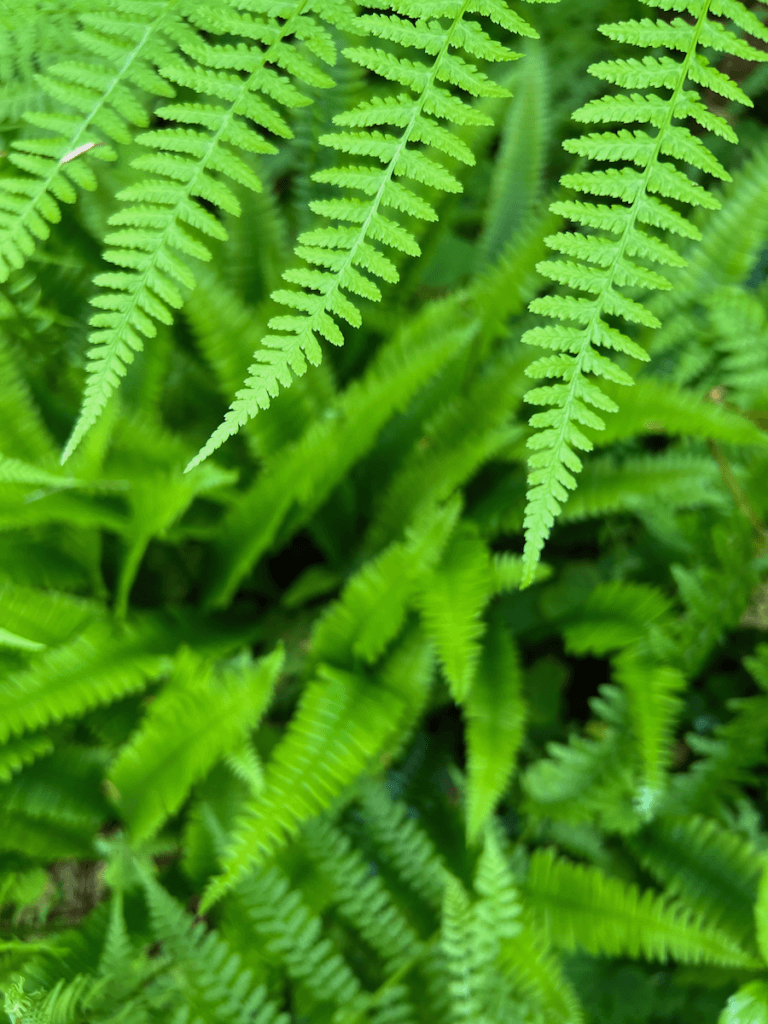Guide to Lake Crescent Lodge
Let the soul float in nature’s magic. Enjoy nature at the stunning Lake Crescent Lodge.
The blue depths of Lake Crescent cleanse the soul. The lake that formed millions of years ago as glaciers sliced through the terrain continues to inspire the freedom to wander — in mind, body, and spirit. Fir trees cascade from steep peaks to the gravelly banks that welcome the slow laps of pristine glacial melt-off. The 12-mile-long lake is perhaps the flagship welcome mark to the vast and majestic Olympic National Park, located in the northwestern corner of Washington State. The entire lake is technically inside the park, even though no gates divide the meandering Highway 101. Just as free as the spirit, the lake is accessible year-round without requiring park fees.
This article provides everything you need to know about Lake Crescent Lodge.
- Where is the lodge?
- Why stay at Lake Crescent Lodge?
- Which rooms to book
- Food and drink, and other amenities
- How to connect with nature
- Day trips from Lake Crescent Lodge
- Other Olympic National Park lodges
- Weather and planning
- How to plan for the Olympic Peninsula
Why should you listen to Matthew Kessi (that’s me)?
- The Pacific Northwest is my lifelong playground.
- As a former travel industry professional, my experience guiding people around Oregon and Washington State gives me valuable insight into the right balance between what is possible and rewarding.
- Unlike big travel websites, I’ve been to all the places, tested the ideas, eaten the food, and taken photos. Unless specified, I don’t receive compensation for naming specific locations — my recommendations come from the heart.
- I visit this area at least twice a year. It is my happy place!
- I’m a practical mystic, which means I actively integrate spiritual sensitivities and meaningful applications in daily life. I can help you find more rewarding experiences grounded in nature — and you can be more present to yourself, your companions, and all the wonders of travel. Check out the growing Kessiworld YouTube channel with magical nature videos designed to help you practice a powerful Nature Connection.

Join me on a Marymere Falls Trail 20 Minute Guided Nature Connection YouTube video.
Quiet your mind, open your heart, and allow your intuition to flow by following this Guided Nature Connection experience in the depths of the Lake Crescent Rainforest.
In this episode we reflect on ways that Nature’s Intelligence can help us embrace self-sufficiency. This is an opportunity to get out of your head and into your own nature!
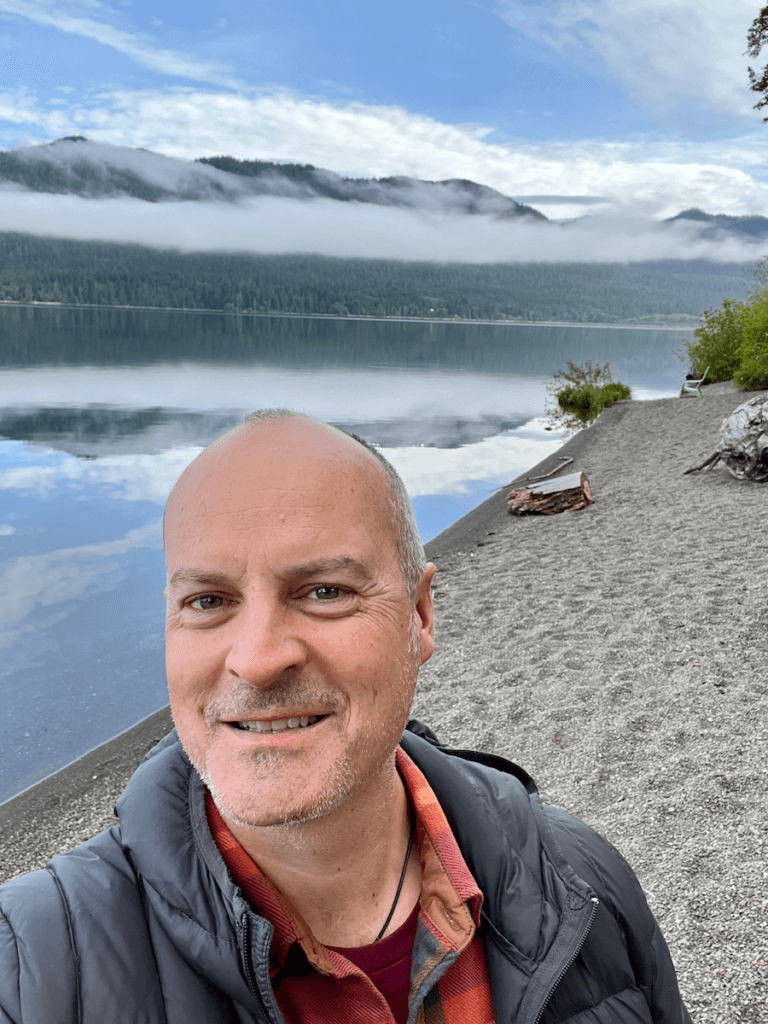
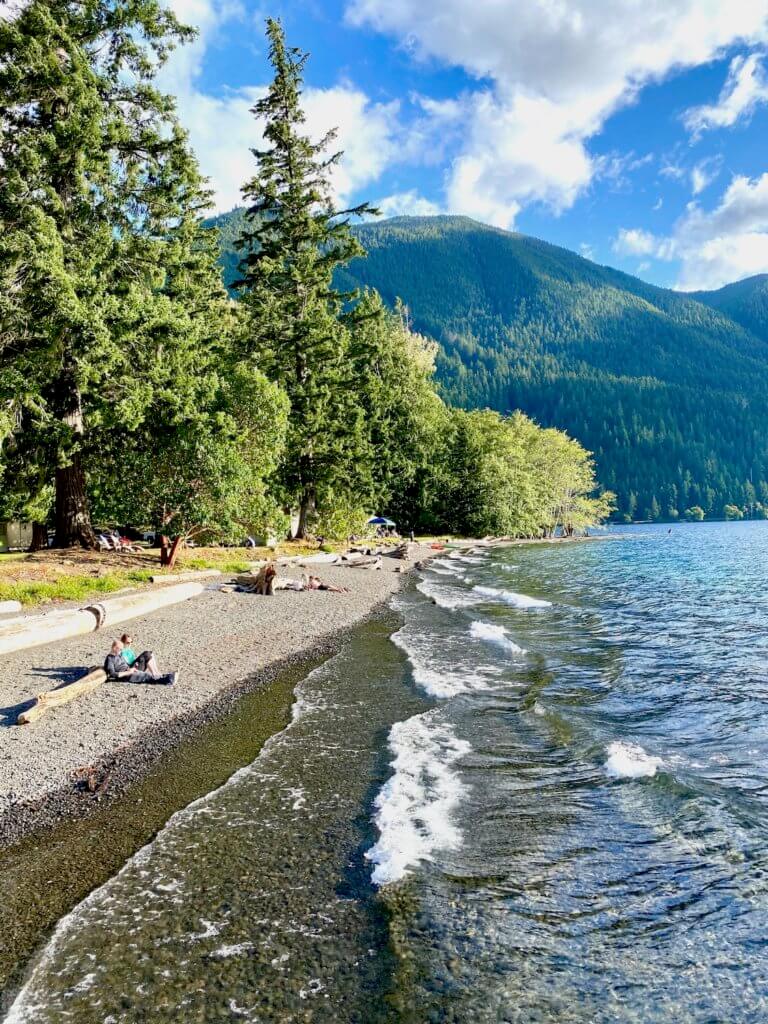
Where is Lake Crescent Lodge located?
A nub of land juts out into the otherwise curve of the water and creates a perfect landing to host all kinds of recreation services — Nature Bridge camp, Storm King Ranger Station, boat launches, beaches, walking trails, and serene Lake Crescent Lodge.
A stay at this WPA (Works Project Administration — a Great Depression-era project to get people working) camp takes a wandering soul back in time — trading out tv, internet, and social media with translucent water seeming to prop up lazy summer sunsets.
The drive to this magical, rustic hamlet offers the first ‘ooos and ahs’, as picturesque Highway 101 hugs the side of the lake — completely running along the southern bank. Either approach (from the east or west) is spectacular and allows a building up of anticipation for that magic to come.
The sign directing travelers to the lodge seems to beckon visitors toward a series of deep forest paths turned roads, and soon enough, your vehicle is surrounded by towering age-old fir trees and fern fronds as high as the deer munching in the meadow that opens up to the lodge encampment.
Driving times from Lake Crescent Lodge:
- Sul Duc Hot Springs: 20 minutes
- Hurricane Ridge: an hour
- Nature Immersion Retreat: 30 minutes.
- Forks, Washington: 45 minutes
- Hoh Valley: 1:30 (entrance congestion varies)
- Port Angeles, Washington: 20 minutes
- Astoria, Oregon (Highway 101 road trip): Four hours
- Seattle: Three hours (traffic varies greatly)
- Portland, Oregon: Five hours (traffic varies greatly)
Why stay at Lake Crescent Lodge?
This is a camp feeling, like the Catskills resort portrayed in the hit 80’s movie Dirty Dancing. There are no corners to put baby because everything faces out to a vast body of water perfectly framed by fir-covered mountains with endless textures and shades of blue and green. Every hour of the day seems to command a new palette of color, and the lodge and surrounding system of dwellings achieve the delicate balance between humble summer camp whimsy and hidden members of the cast of thousands of plants and animals joining together to support and frame the lake.
The lodge is open in the summer and makes a great day trip destination from Port Angeles or stop along a more in-depth loop of the Olympic Peninsula.
While the day-trip option still soothes the soul, a night or two (or a week) of fresh lake air does a body good. The following information aims to provide the best framing of a perfect nature getaway.
If you want to incorporate a visit to this soulful place into a longer journey, access my article, How to plan an Olympic Peninsula road trip, for all the details.
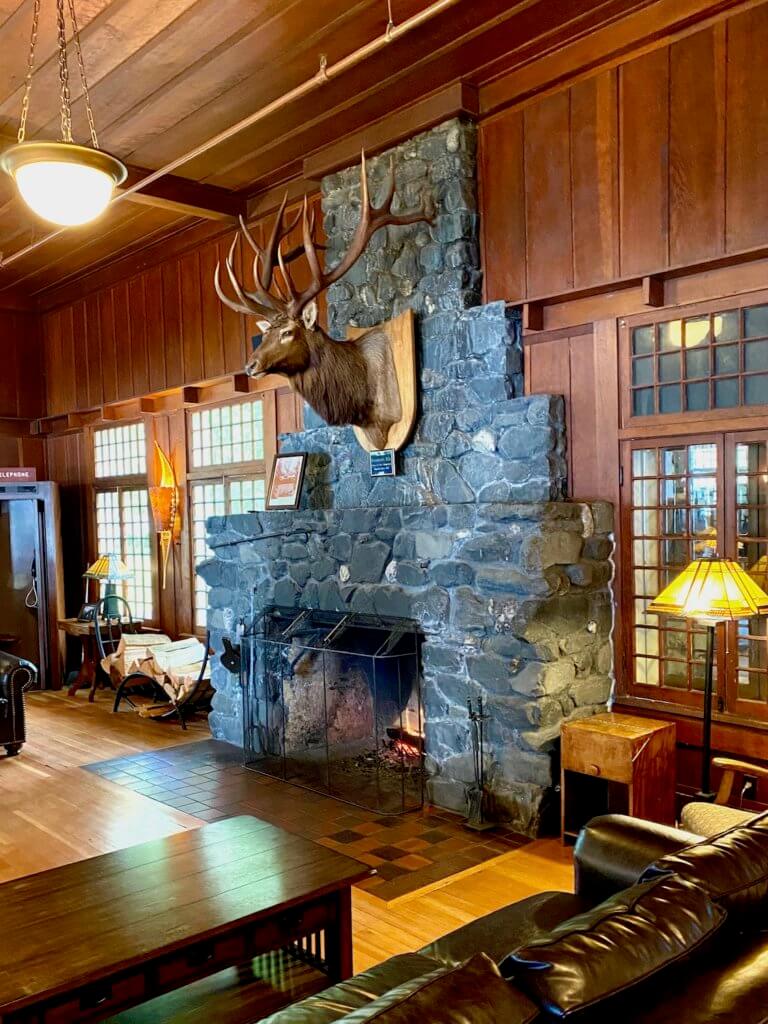
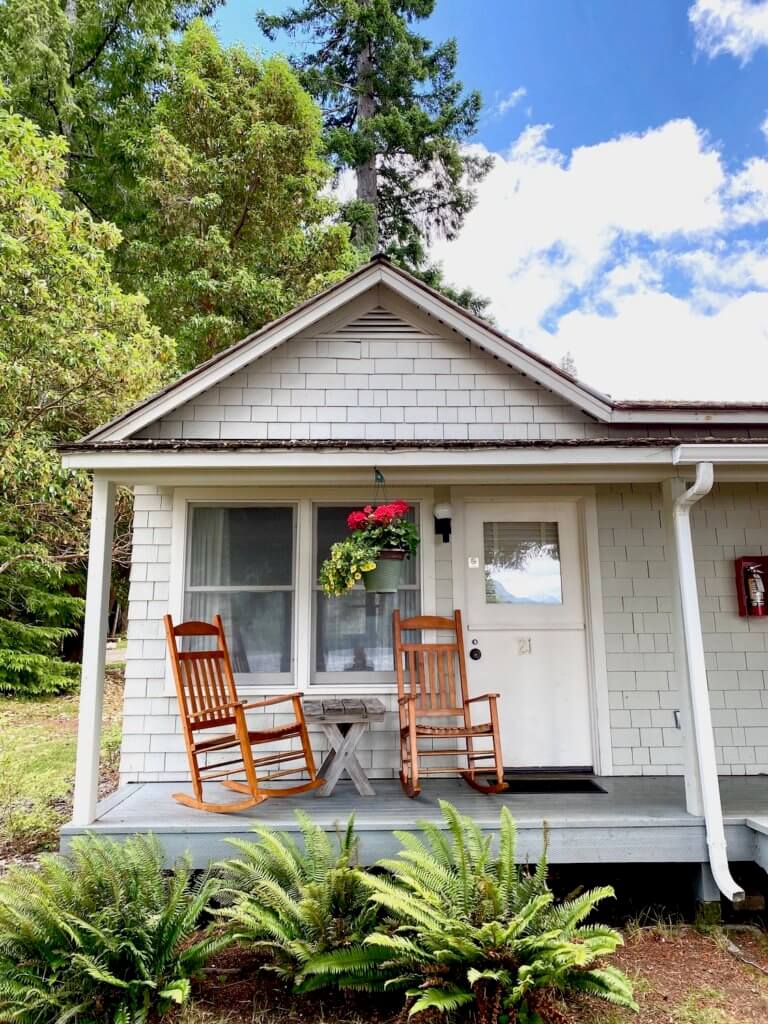
Lake Crescent Lodging — the best rooms to book?
Aramark handles the National Park contract for several of the lodges in the Olympic National Park. Their site isn’t super friendly, especially since it’s required to submit a request which is then processed for confirmation a few hours, or, days later. For best results, call the National Parks reservations line.
Speaking of which, you will not find them on the big booking platforms or search engines finding places to stay. If you’re interested in other favorites that “fly under the radar”, check out my 25 hidden Oregon and Washington Hotels article.
Checking out the official lodge site can provide further details, but the skinny on the different room types is here.
- Rooms in the lodge. Cozy feeling to walk downstairs to a fire roaring in the giant fireplace capped by the head of a massive Roosevelt Elk. Think about the size of a hotel room from the 1930s with a bathroom down the hall. I love the nostalgia, so this would be a romantic option. Not pet-friendly.
- Roosevelt Fireplace Cabins. This is a charming series of three cabin units located just off the serene banks of the lake. Parking is convenient, and this is an excellent option for larger groups, families, and pets. These book up way in advance, like nine months ahead, especially on weekends and the thick of summer.
- Singer Tavern Cottages. Dirty Dancing, here we come. Cute rustic cabins line the main entrance lawn to the lodge. Hanging begonias frame in tiny porches with rocking chairs well positioned to soak in all the charm from every squeaky floorboard. Some of the cottages are pet friendly.
- Marymere. This wing is reminiscent of the 1950s and every room looks out toward the bank of the lake. I appreciate the larger room size and peaceful views. These are not pet friendly.
- Pyramid and Storm King. Two different two-story buildings that harken back to the 1970s on the outside and a quaint forest lair on the inside. I love these spaces because they are a little deeper into the forest environment, making it easy to walk up and gaze out the windows at robins flying from fern to fern underneath old-growth timber. Pet friendly (Pyramid only) and plenty of more modern space and furnishings.
Lake Crescent Lodging — restaurant, service, and amenities
Although the dining area is open for in-restaurant seating, most people order the breakfast, lunch, and dinner options to-go and eat in the window-clad solarium or outside on the porch or options closer to the lake. Order food from the intimate bar in the corner of the lobby, along with any other beverage desires — the friendly staff serves up a full bar. Of note, the lodge serves non-guests as well, making this an excellent stop for a snack and drinks along a day trip or “passing through” route.
This lodge is rustic and peaceful and is a place to enjoy the disconnect from daily noise — including TVs, email, and social media. There is some form of free guest Wi-Fi, but it’s not worth the effort — detach or use the reasonably strong cell service available throughout most of the recreation area.
The lodge has a gift shop with a generous assortment of National Park paraphernalia, including the beautiful Olympic National Park version of the Pendleton blanket series. Check out a tchotchke honoring Sasquatch and pick up a postcard or two.
Kayaks and paddle boards are available to rent just before the lodge. The options are a five-hour package (8 am-1 pm) or all day (8 am-5 pm.)
The grounds of the recreation area house many picnic tables and areas to set up a day camp. There are numerous parking lots without fees and even two electric car charging stations that require reservations.
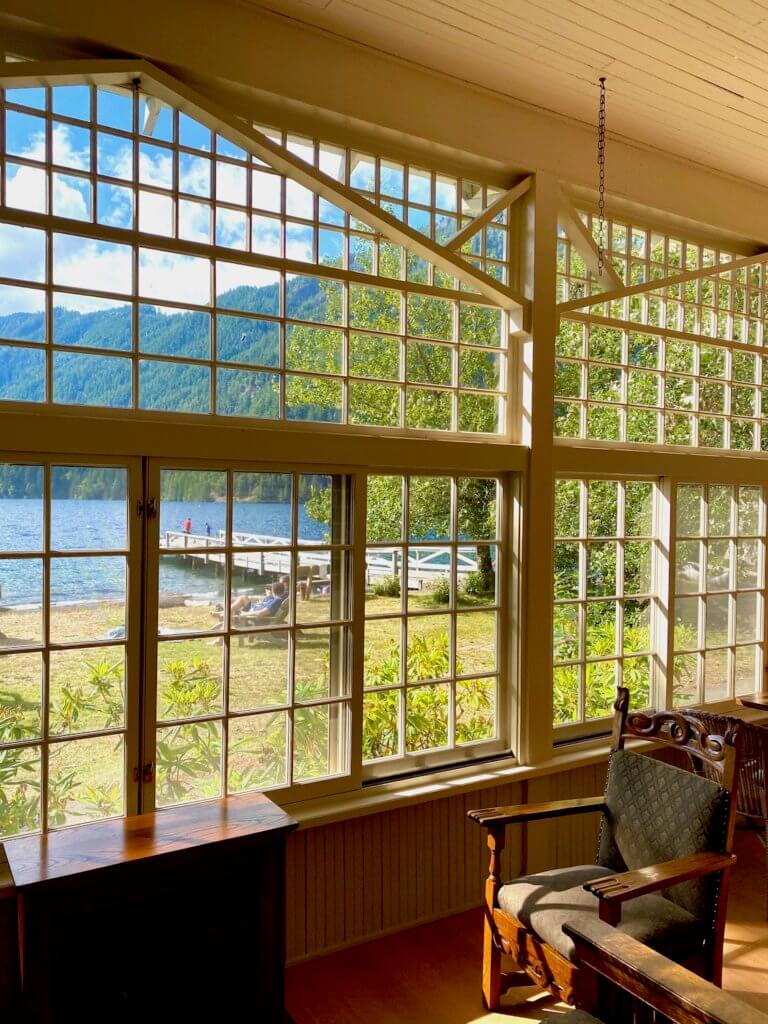
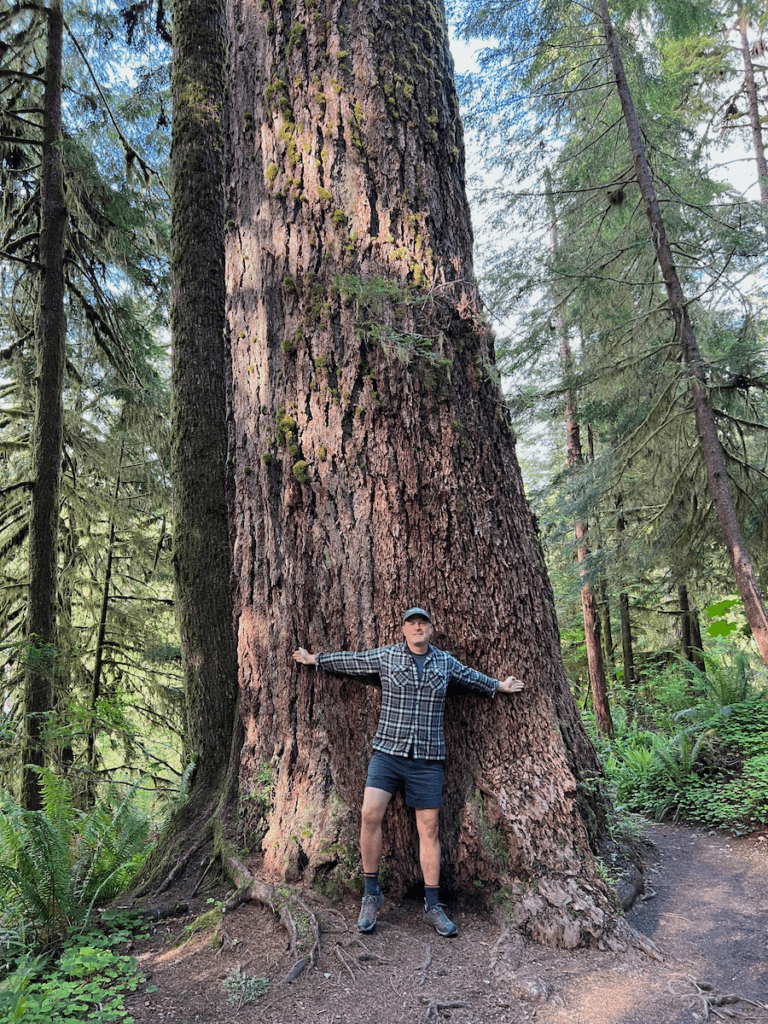
Nature near Lake Crescent Lodge
It’s tempting to stay put on a comfy Adirondack chair with a book while soaking up the powerful energy of the water and surrounding waves of green forest. Or, why not jump off the central dock into a rush of frigid but oddly satisfying lake water? There is plenty of nature around the wood buildings, but if the sights are set on more movement, consider these quick and easy nuggets of nature steps away.
- Marymere Falls. This easy path winds from the lodge through massive old-growth fir trees to a spectacular 90 ft waterfall deep in the damp, oxygen-rich forest. Most of the trail is accessible, but the final rise to the waterfall involves an elevation gain of about 400 feet. (1.8 miles roundtrip.) See YouTube video below.
- Moments in Time. A self-guided tour that is accessible and weaves from lakeside respites to deep forest vegetation with interactive signage. This is an easy way to ponder some ancient trees. (1.2 miles, flat)
- Mt. Storm King. The switchback-rich trail raises the heart rate but opens up to sweeping views of the lake and surrounding terrain. (4.4 miles, 2,000 elevation gain)
- Fairholme Campground Loop. Quick and easy loop through an old-growth forest. (.8 miles, 100 elevation gain)
- Pyramid Peak. Climbs to a WW II spotting tower with views of the lake. (7 miles, 2600 elevation gain)
- Aurora Creek. Upward climb through old-growth forests to Aurora Ridge. (6.8 miles, 3,220 elevation gain)
- Barnes Creek. Much longer hike with only about half of the distance on maintained trails. (15 miles, 4,200 elevation gain)
The Spruce Railroad was designed to haul timber to mills around Port Angeles during WW II, but the line was completed just after the war ended in 1945. The tracks were used for some years, but more recently, the National Park has reclaimed this right-of-way, turning it into a 4-mile-long path. The old railroad bed hugs a good portion of the lake’s northern shore and is bike and pet friendly.
Do you want to practice a nature connection with Lake Crescent Rainforest today?
The most magical and memorable experiences at Lake Crescent Lodge come from taking time to slow down and find grounding. This allows you to open up to a newfound sense of belonging, even if you’ve never visited Washington State before.
If you need clarification on what this means or are well-versed in nature connection but still curious, consider joining me for one of my YouTube videos. They are all about finding your way to tap into Nature’s Intelligence, regardless of your experience level or location. You’ll have access to my lifelong mystic gift of leading people into their own wild nature — in ways that might surprise you.
And the more you practice, the more you’ll be ready for transformational experiences in the magical rainforest around Lake Crescent Lodge. It starts with allocating 20 minutes of your day to mindful time in the Natural World.
Why 20 minutes???
A growing body of research points to the beneficial effects of exposure to the natural world on health, reducing stress, and promoting healing. Some studies further clarify that only 20 minutes daily (of immersive natural experience) is essential to producing lasting benefits such as lower blood pressure, higher concentration, improved mental health, and neutralizing inflammation.
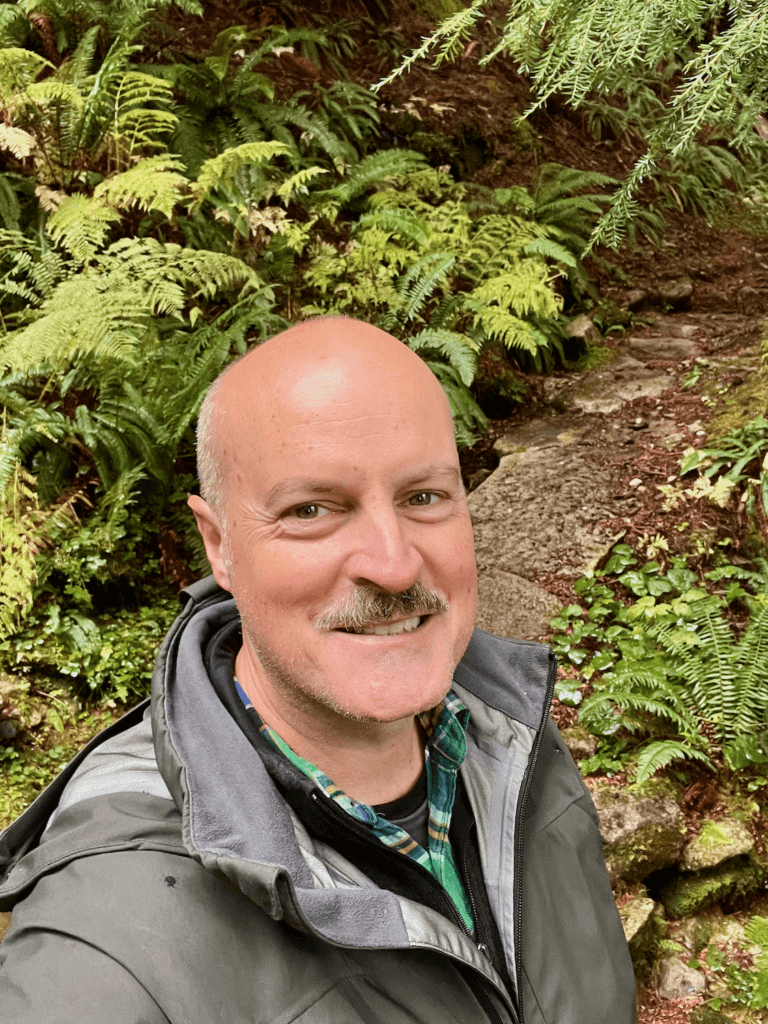
Join me on a YouTube video on the trail to Marymere Falls — a 20 Minute Nature Connection.
Quiet your mind, open your heart, and allow your intuition to flow by following this Guided Nature Connection experience in the depths of the Lake Crescent Rainforest.
In this episode we reflect on ways that Nature’s Intelligence can help us embrace self-sufficiency. This is an opportunity to get out of your head and into your own nature!
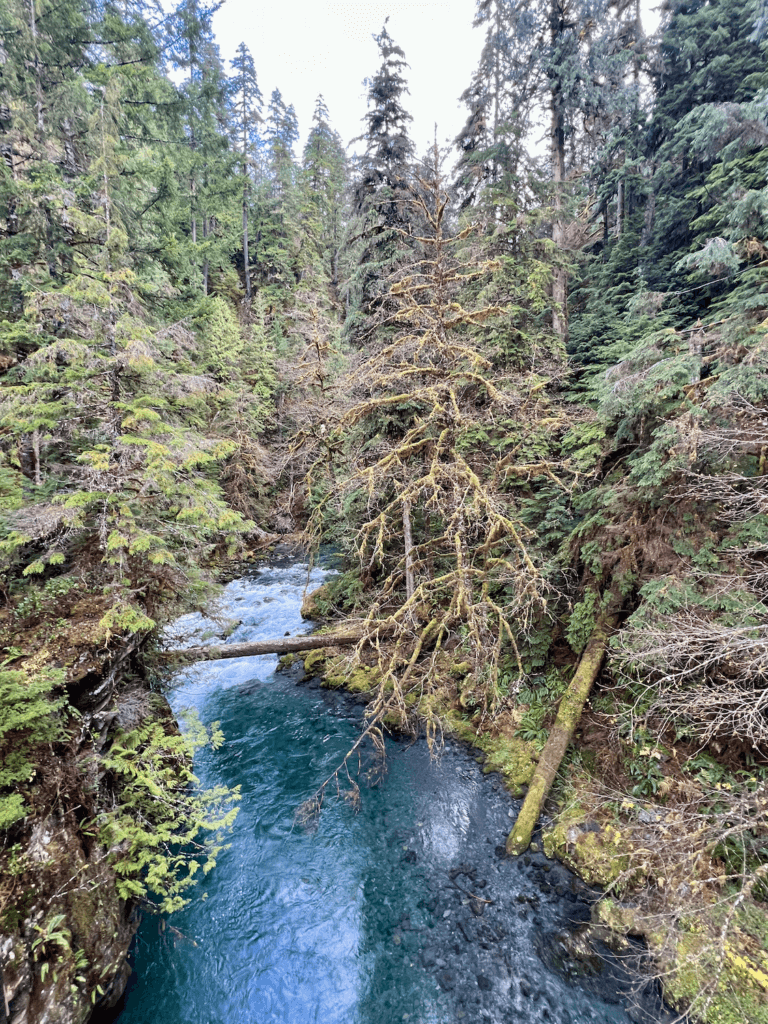
Day trip options from Lake Crescent Lodge
This gateway area to the Olympic National Park is a great location to set up a more extended stay to enjoy great day trips in and around the northern parts of the park. Here are a few great options within a day-trip distance from Lake Crescent.
- Hurricane Ridge. A famous 17-mile highway that seems to ascend to the gods on a ridiculously scenic, windy road. A park entrance fee is required, and the attraction is bustling on weekends and throughout the summer. There are great short hikes and an easily accessible vista to enjoy a picnic lunch.
- Salt Creek Recreation Area. This park sometimes gets left out of all the acclaim enjoyed by the Olympic National Park but is worthy of the time needed to explore the rocky shores of the Strait of Juan de Fuca. Stop at the cute country store in Joyce for a snack and continue to the saltwater park. Be sure to explore the area around Tongue Point.
- Sol Duc. The hot springs are open on a first-come, first-served basis, but many options for hiking along the mighty bubbling Sol Duc River exist. Note that this requires a park entrance fee.
- Port Angeles. Lake Crescent Lodge is technically in Port Angeles, the regional economic hub and gateway to Victoria, Canada, through the Black Ball Ferry. Nonetheless, Port Angeles has a charming downtown core with antique stores, tiny galleries, and several good food options. New Day Cafe is tasty for lunch, and Country Aire Natural Grocery is helpful for charcuterie supplies.
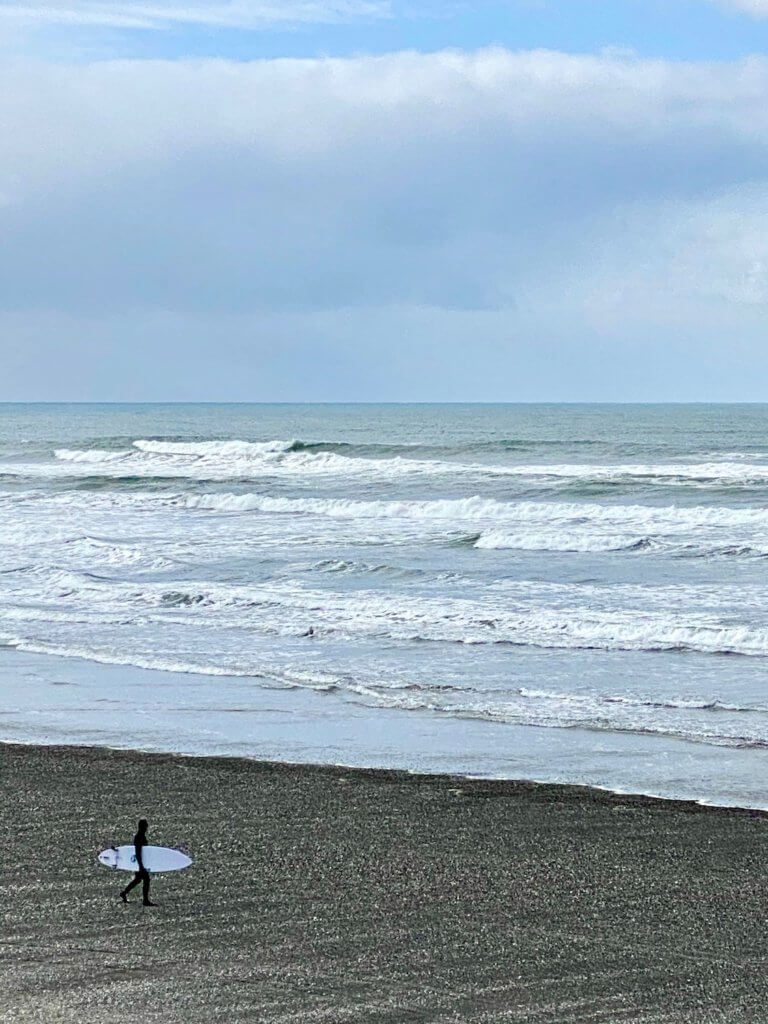
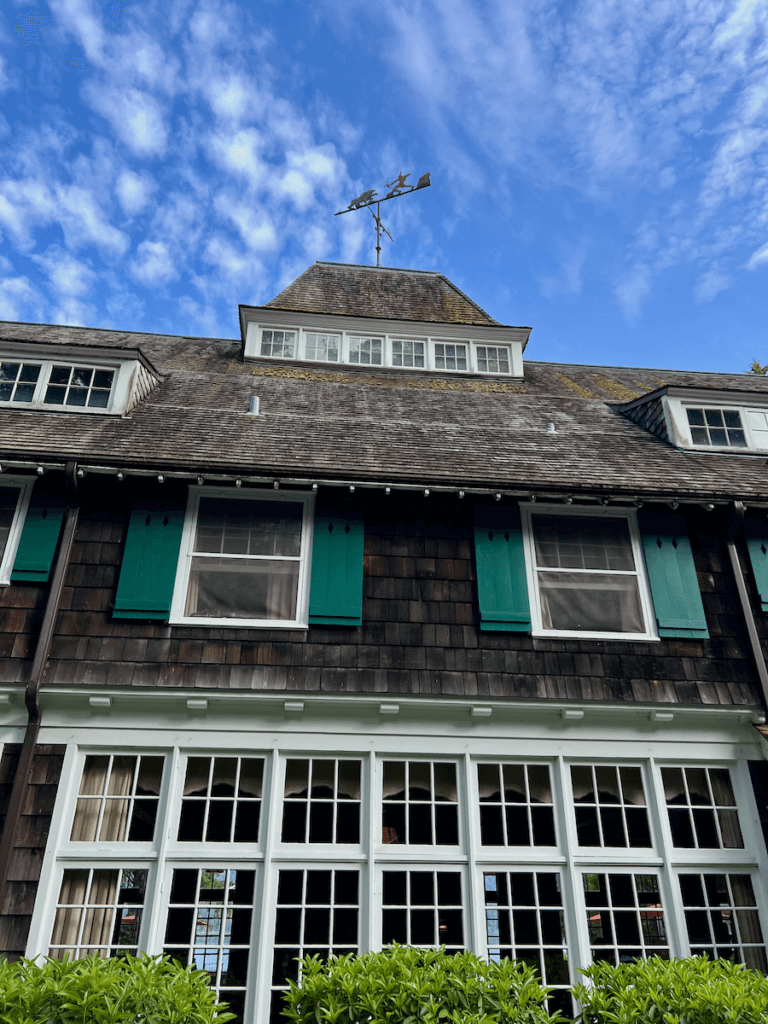
Olympic National Park lodges
The Olympic National Park was officially established on June 29, 1938, a year after Franklin Roosevelt’s famous visit to the temperate rainforest area. The president and assorted influencers met at now Lake Crescent Lodge (called Singer’s Tavern back then) to iron out the details of a controversial proposal to establish a large national park on the Olympic Peninsula. Over time, the park grew to include several unique lodges that remain excellent options for overnight adventure on the Olympic Peninsula.
Here are some other articles about my favorites places to stay on and around the Olympic Peninsula:
How to plan an epic Olympic Peninsula road trip
I’ve guided myself and others through nature worldwide, including this beautiful, wild corner of Washington State. Many people spend too much time driving when they could allow deeper nature connections — which is the whole purpose of visiting Olympic National Park and Lake Quinault Lodge. I’ve created a thorough planning resource to help anyone with limited time (less than four days) balance what is possible with what is rewarding. Access this article, How to plan an Olympic Peninsula road trip.
Olympic Peninsula — weather and planning
The Olympic Peninsula is a temperate rainforest famous for wet weather any time of year, so always have a solid waterproof outer shell. If hiking is planned, be prepared with waterproof boots and hiking shoes. Take layers, especially because early mornings, any time of year, can be cool, opening up to warmer afternoons and evenings. Once the sun sets, the usual is back to hoodie conditions.
The area, particularly Lake Crescent, seems to have a colder micro-climate, so between October and April, be sure to have winter clothing (gloves, boots, and hats) on hand, just in case. The Pacific Northwest doesn’t present apparent heat and beach-like conditions, but the sun still has power, especially in the summer around the lake. Be mindful of the rays, wear sunscreen, and take plenty of water if planning longer hikes.
As for fees, the Olympic National Park is $30 per car pass, valid for seven days. The Olympic Annual Pass (valid for Olympic National Park for 12 months) is $55, and for America, the Beautiful, for all National Parks, the annual pass is $80. It’s easy to purchase upon arrival, but other options, including the complete fee structure, are on the NPS website. Remember that there are no park fees around Lake Crescent, but places like Sol Duc Hot Springs and Hurricane Ridge require entrance fees.
